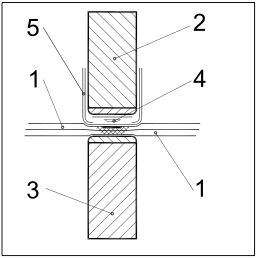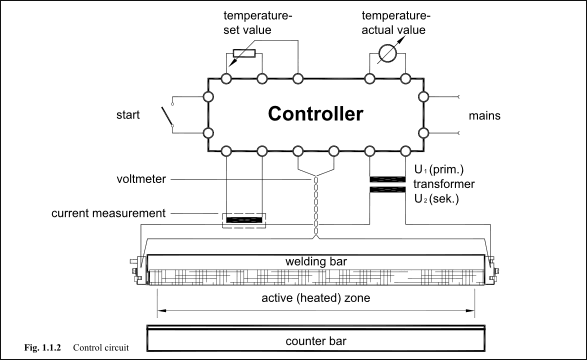Thermal impulse sealing

Fig. 1.1.1 Drawing of the thermal impulse sealing method
Two film layers (1) are placed between two jaws, a seal bar (2) and a counter jaw (3), which press them together. The heating element (4) is provided with a thermal and electrical insulation on the support’s side and a non-stick coating (5) on the film’s side. The counter jaw is also thermally and electrically insulated. An impulse of electrical current is passed through the heating element causing it and the film layers beneath it to heat. The heat causes the film layers to plastify, fusing them firmly together (= sealing). The most important influencing variables for this process are:
- pressure,
- temperature and
- time
The sealing process is generally followed by a cooling time during which the plastified material is allowed to cure to its full strength.
The most important factor is the strength of the seal achieved by using this method. In contrast to the sealing of metallic materials, in this method only the transition area from the unheated zone to the heated zone has an influence on the result.
The more sudden the transition is made the worse will be the result. The pressure applied to the sealing jaws also forces the material out of the seal area. The softer the transition the stronger the seal.
This displacement effect, which in the strict sense is an unfavourable effect, is turned to account in the cutting seal method. The heating element is given a profile which forces the film material out of the seal area until the material is completely separated. The figures in point 2.3.1 show an overview of the different profiles and their respective sealing results.
In principle, the impulse sealing method offers the widest range of possibilities which can be varied to achieve the desired results. However, this may not be necessary for all applications, or not possible due to high machine speeds.
In most cases the heating elements have a straight-lined design. But also even contours may be possible (form sealing bands). The resistance along the contour is constant to achieve the necessary heating.
Adherence to the sealing parameters is decisive for the final result. While this is relatively easy as regards pressure and time, keeping the necessary temperature of the heating element poses a problem. When using low-cost installations or working at low speeds a time control is still used today. A defined flow of current is passed through the heating element for a set time. However, the actual temperature is not measured. Even so, this method provides satisfactory results.
Today, nearly all modern machines are equipped with an electronic temperature control. This control uses the heat conductor’s characteristic of changing its electrical resistance in accordance with the temperature. This configuration eliminates the need for an additional sensor.

The electronic temperature control is used to produce sealing seam in a constant quality. The use of a temperature control is advantageous, especially when working with thick film materials, as the temperature can be kept constant over a preset period of time. The method depends on the thermal conductivity of the film materials. If the heating of the sealing area took place slowly, the time control would lead to an overheating of the film which is in direct contact with the heating band.
If a temperature control is used, however, all materials will be heated up to the necessary temperature level only. The result of it is a longer service life as shown in the following diagram.
